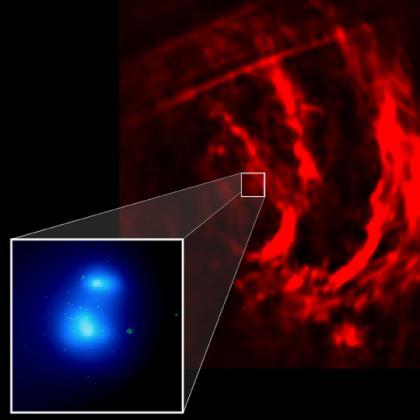
A composite image of the hot X-ray emitting gas (blue inset) around a young cluster of stars known as the Arches cluster, taken by Chandra; the image is overlayed with a Hubble infrared image of the same region in which some individual stars appear. The larger red image shows the spectacular filamentary structures that appear in radio wavelengths (from the VLA. Astronomers have concluded that some of the X-ray emission from the Arches is reflected lX-ray light from flares in the galactic center's supermassive black hole.
The Arches cluster is a massive star cluster located in the Galactic Center region of our galaxy, about one hundred light-years from the galaxy's supermassive blackhole, SgrA*, and about twenty-five thousand light-years away from us. The cluster is the densest known star cluster in our galaxy: in a volume spanned by a radius equal to that between the Sun and its nearest neighbor star, the Arches would have about one hundred thousand stars. The cluster contains more than 160 hot young ("O-type") stars whose initial masses were more than twenty solar masses.
The first X-ray observation of the region around the Arches cluster with Chandra revealed it to have strong bright X-ray emission, characterized by a strong emission line of highly ionized iron. The hot emission around the cluster's core was attributed to the multiple collisions between the strong winds of its massive stars. Non-stellar emission from the rest of the cluster was thought to come from the gas being excited by external X-ray emission, perhaps from SgrA* itself, or else possibly from bombardment by cosmic rays. Between 2000 and 2013, X-ray observations of the Arches with the XMM-Newton X-ray satellite revealed a dramatic decline in the intensity of the X-ray emission by about 30%. The scientists argue that drop in the cluster X-ray emission was so abrupt that it is more likely have to resulted from a drop in reflection of a bright X-ray flare in Sgr A* rather than from in some abrupt change in the local conditions. CfA astronomer JaeSub Hong was a member of a team that used the NuSTAR and XMM-Newton X-ray satellites to understand the origin of the cluster's changing X-ray emission. Their spectral analysis of the iron emission leads them to conclude that the emission had two separate components and they suggest that two separate, bright flares of SgrA* were responsible for the emission peaks.
"Investigating the Origin of the Faint Non-Thermal Emission of the Arches Cluster Using the 2015–2016 NuSTAR and XMM–Newton X-ray Observations," Ekaterina Kuznetsova, Roman Krivonos, Maïca Clavel, Alexander Lutovinov, Dmitry Chernyshov, JaeSub Hong, Kaya Mori, Gabriele Ponti, John Tomsick, and Shuo Zhang, MNRAS 484, 1627, 2019.